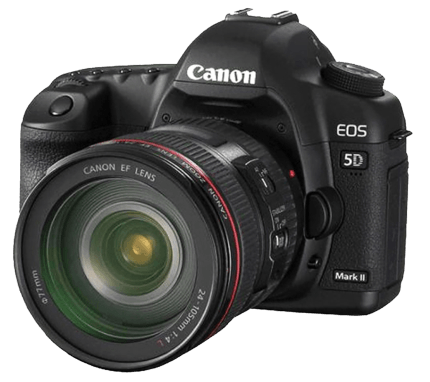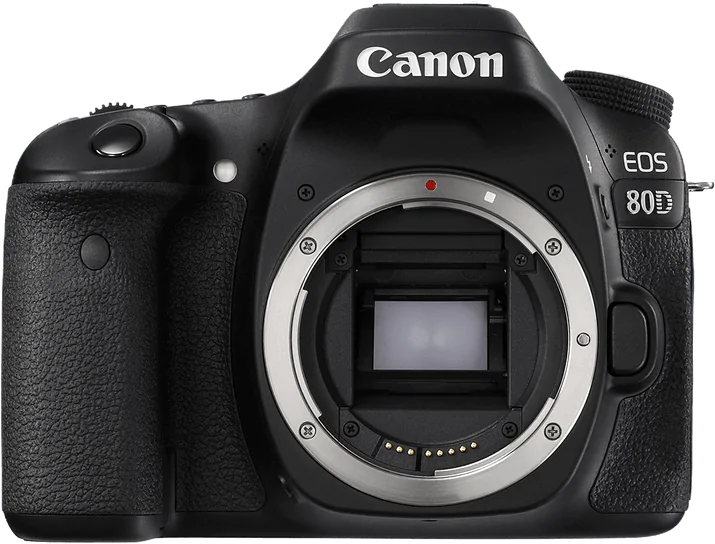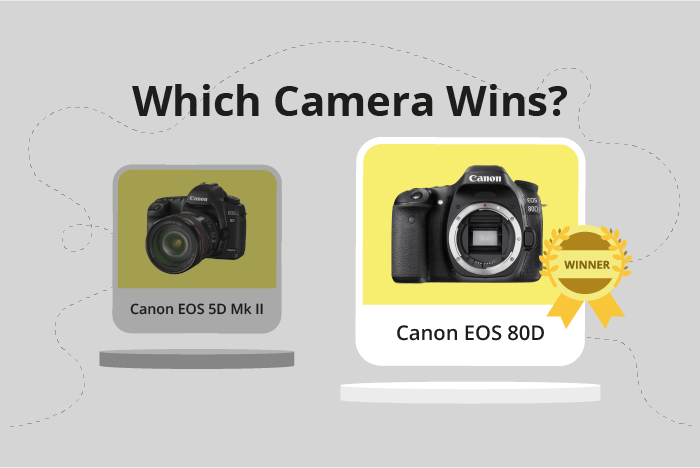Canon EOS 5D Mark II vs EOS 80D Comparison
Canon EOS 5D Mark II

Canon EOS 80D

The Canon EOS 80D outperforms the Canon EOS 5D Mark II with a score of 64/100 compared to 56/100. Both cameras are DSLRs, sharing similar features, but there are notable differences. The 80D, released in 2016, is more affordable with a launch price of $1200, while the 5D Mark II, from 2008, debuted at $2199.
The winning camera, the EOS 80D, is also lighter at 730g and more compact, measuring 139 x 105 x 79mm. On the other hand, the EOS 5D Mark II is heavier at 850g and larger, with dimensions of 152 x 114 x 75mm.
Despite the 5D Mark II’s lower score and older release date, it might still appeal to users who prefer a more substantial camera body. However, the EOS 80D’s higher score, lower price, and lighter weight make it a more attractive option for most photographers.
Canon EOS 5D Mark II vs EOS 80D Overview and Optics
The Canon EOS 80D wins in the optics comparison with a score of 63/100, while the Canon EOS 5D Mark II scores 59/100. Both cameras share some specifications, including a CMOS sensor type, Digic processors, a DXOMARK score of 79 for the sensor, and no image stabilisation. However, there are key differences that set these cameras apart.
The EOS 80D outperforms the 5D Mark II in several aspects. It has a higher megapixel count at 24.2 compared to the 5D Mark II’s 21 megapixels. This provides the 80D with greater image resolution and detail. Moreover, the 80D has a faster shooting speed of 7 frames per second, making it more suitable for capturing fast-moving subjects and action shots. The 80D also has a more advanced processor, the Digic 6, which contributes to better overall performance and image processing.
On the other hand, the 5D Mark II has a full-frame sensor, which enables it to capture more light and produce better image quality, especially in low light situations. This advantage is somewhat offset by the 80D’s higher megapixel count, but it still remains a strong point for the 5D Mark II. Additionally, the 5D Mark II features a Canon EF lens mount, allowing for compatibility with a wider range of lenses compared to the 80D’s Canon EF-S mount.
Taking these factors into account, the Canon EOS 80D is superior in terms of resolution, shooting speed, and processing power. However, the Canon EOS 5D Mark II still holds its ground with a full-frame sensor and a more versatile lens mount. Ultimately, the choice between these two cameras depends on the specific needs and preferences of the user.
Canon EOS 5D Mark II vs EOS 80D Video Performance
The Canon EOS 80D comes out ahead in terms of video capabilities, scoring 70/100 compared to the Canon EOS 5D Mark II’s score of 43/100. Both cameras share some common specifications, such as having a maximum video resolution of Full HD and video dimensions of 1920 x 1080. However, there are significant differences between the two cameras that contribute to the EOS 80D’s higher score.
The EOS 80D has a higher maximum video frame rate of 60fps, which means it can capture smoother and more detailed footage compared to the EOS 5D Mark II’s maximum frame rate of 30fps. This is especially important for fast-moving subjects or slow-motion video playback. Additionally, the EOS 80D has built-in time-lapse functionality, allowing users to create stunning time-lapse videos without requiring additional equipment or software. These features make the EOS 80D a more versatile option for video creators.
While the EOS 5D Mark II’s video capabilities may not be as advanced as the EOS 80D’s, it still offers decent performance for casual video recording. The Full HD video resolution and 1920 x 1080 video dimensions are sufficient for most users, and the 30fps frame rate is adequate for general use. However, its lack of time-lapse functionality and lower frame rate put it at a disadvantage compared to the EOS 80D.
Taking these factors into account, it is clear that the Canon EOS 80D surpasses the EOS 5D Mark II in terms of video capabilities. The EOS 80D’s higher frame rate and built-in time-lapse functionality make it a more appealing choice for video enthusiasts. Meanwhile, the EOS 5D Mark II remains a viable option for casual video recording, but users seeking more advanced features should consider the EOS 80D.
Canon EOS 5D Mark II vs EOS 80D Features and Benefits
The Canon EOS 80D emerges as the winner with a feature score of 70/100, while the Canon EOS 5D Mark II scores 54/100. Both cameras share a 3-inch screen size, lack of GPS, and absence of Bluetooth. They also both have WiFi capabilities.
The EOS 80D outperforms the 5D Mark II in terms of screen resolution, offering 1,040,000 dots compared to the 5D Mark II’s 920,000 dots. Moreover, the EOS 80D is equipped with a touchscreen and a flip screen, making it more user-friendly and versatile for various shooting situations. These additional features contribute to the higher score of the EOS 80D.
Although the EOS 5D Mark II has a lower feature score, it still has its advantages. It shares common specifications with the EOS 80D, such as screen size, WiFi, lack of GPS, and absence of Bluetooth. However, it falls short in terms of screen resolution, touchscreen, and flip screen capabilities, which might be less important for some users depending on their preferences and needs.
Taking these factors into account, the Canon EOS 80D is the better camera in terms of features, offering a higher screen resolution, touchscreen, and flip screen. The Canon EOS 5D Mark II, while not as feature-rich, may still be suitable for users who prioritize other aspects of a camera and do not require the additional functionalities offered by the EOS 80D.
Canon EOS 5D Mark II vs EOS 80D Storage and Battery
The Canon EOS 80D outperforms the Canon EOS 5D Mark II in storage and battery with a score of 43/100 compared to 37/100. Both cameras have one memory card slot and neither supports USB charging. The EOS 80D accepts SD, SDHC, and SDXC (UHS-I compatible) memory cards, while the 5D Mark II takes Compact Flash (Type I or II), UDMA, and Microdrive cards.
The EOS 80D has a longer battery life, providing 960 shots per charge, whereas the 5D Mark II offers 850 shots. The 80D uses an LP-E6N battery type, while the 5D Mark II uses an LP-E6 battery.
Despite the lower score, the 5D Mark II’s storage options may appeal to photographers who prefer Compact Flash cards. However, the EOS 80D’s longer battery life and compatibility with more commonly used memory cards make it the superior choice for storage and battery performance.
Canon EOS 5D Mark II vs EOS 80D – Our Verdict
Are you still undecided about which camera is right for you? Have a look at these popular comparisons that feature the Canon EOS 5D Mark II or the Canon EOS 80D:

